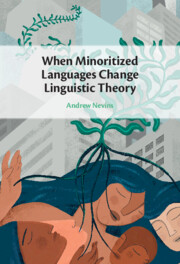Book contents
- Frontmatter
- Dedication
- Frontmatter
- Contents
- Figures
- Acknowledgments
- Abbreviations
- Map
- 1 Expanding the Canon: Minoritization in the World and in Linguistic Theory
- 2 Indexical Shift in Zazaki and Uyghur
- 3 Why Ergative Case Requires Structure in Basque and Ch’ol
- 4 Closest Conjunct Agreement in Slovenian and Xhosa
- 5 Configurationality of Objects in Chichewa and Warlpiri
- 6 Partial Nasality in Maxakalí and Kaingang
- 7 Symmetric Hands in Sign Language Phonologies
- 8 Number-Encoding on Verbs in Hiaki and Chechen
- 9 Conclusion: Towards Healthy Futures in the Language Sciences
- Bibliography
- Index
4 - Closest Conjunct Agreement in Slovenian and Xhosa
Published online by Cambridge University Press: 18 November 2022
- Frontmatter
- Dedication
- Frontmatter
- Contents
- Figures
- Acknowledgments
- Abbreviations
- Map
- 1 Expanding the Canon: Minoritization in the World and in Linguistic Theory
- 2 Indexical Shift in Zazaki and Uyghur
- 3 Why Ergative Case Requires Structure in Basque and Ch’ol
- 4 Closest Conjunct Agreement in Slovenian and Xhosa
- 5 Configurationality of Objects in Chichewa and Warlpiri
- 6 Partial Nasality in Maxakalí and Kaingang
- 7 Symmetric Hands in Sign Language Phonologies
- 8 Number-Encoding on Verbs in Hiaki and Chechen
- 9 Conclusion: Towards Healthy Futures in the Language Sciences
- Bibliography
- Index
Summary
In this chapter, the contributions of teams working together on South Slavic and Southern Bantu languages, many of which began specifically as new research partnerships forged after the dissolution of the former Yugoslavia and the end of apartheid, provide compelling evidence that syntactic processes must include reference to linear order. Syntax may not be just a spinning Calderian mobile: Agreement in gender for cases of conjoined NP subjects (and possibly objects) refers to the NP linearly closest to the verb.
- Type
- Chapter
- Information
- When Minoritized Languages Change Linguistic Theory , pp. 42 - 60Publisher: Cambridge University PressPrint publication year: 2022

